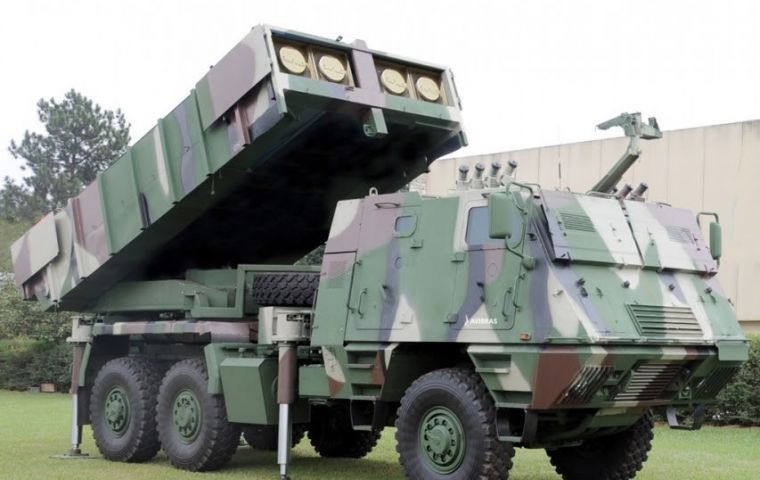MercoPress. South Atlantic News Agency
Brazil re-launches industry to develop high precision rockets and missiles
 Under military rule Brazil developed profited from precision rocket exports mainly to Mid East
Under military rule Brazil developed profited from precision rocket exports mainly to Mid East Brazil is pursuing a multimillion-dollar program to revive and modernize its precision strike technologies with the aim of developing rockets and missiles both for domestic military use and exports.
Brazil under military rule from the mid-1960s to mid-1980s profited from precision rocket exports, many to former Iraqi strongman Saddam Hussein and Arab states in the Persian Gulf.
The end of the Iraq-Iran war and the Cold War set Brazil's defence industry back, with production shutdowns, job losses and collapse of the export market but all that is intended to change.
The one billion Real (480 million dollars) initial outlays by the Defence Ministry is focused on updating Avibras' ASTROS, acronym for Artillery SaTuration ROcket System, which is capable of launching multiple rockets.
A modernized ASTROS 2020 configuration will include the production of a GPS-guided short-range rocket and an AV-TM300 missile that gives the new system a 180-mile strike range.
That level of reach would stand out in the global market, as it would rival the US Multiple Launch Rocket System and Army Tactical Missile System combined, Defence Industry News said on its website.
Analysts said the Brazilian investment indicated the government's strategy to regenerate defence manufacturing neglected over nearly three decades.
Brazil has been investing in research and development of GPS-guided rockets and has sought to increase their range during the development process. Earlier versions of 180mm SS-AV-40 guided rockets are known to have a range of about 25 miles but Brazilian research has also looked into developing jet-powered cruise missiles to increase the range.
A full ASTROS system includes one battalion level command vehicle in charge of three batteries, fire control vehicles, rocket launchers, ammunition re-supply vehicles, recovery vehicles and a mobile weather station.
The vehicles are usually transported in a C-130 vehicle but Brazil's Embraer aircraft maker is also developing a tactical military transport aircraft that hopes to compete with the Hercules as well as rivals from Europe, Russia and Israel.
Brazil's defence revival has seen a hard fight to claw back market share when its Engesa S.A. filed for bankruptcy in 1993 after Avibras applied for bankruptcy protection in 2008 but was rescued with government funding.
As part of the support incentives, the Defence Ministry in August announced financing of 760 million dollars from its Growth Acceleration Program. At least 30 Astros and associated vehicles are likely to be part of that acquisition.




Top Comments
Disclaimer & comment rules-

-

-

Read all commentsSeems like the “peaceful” people of Brazil are militarizing the south atlantic. Though these seem more geared to something like a border war.
Dec 20th, 2012 - 01:20 pm 0Looks a nice bit of kit, stick with the MRLS though, proven technology, garuanteed to ruin someones day.
Dec 20th, 2012 - 01:26 pm 0Aparently they will be deployed along the argentine border, just in case
Dec 20th, 2012 - 01:53 pm 0any mad cows cometh north,
so they say..
Commenting for this story is now closed.
If you have a Facebook account, become a fan and comment on our Facebook Page!